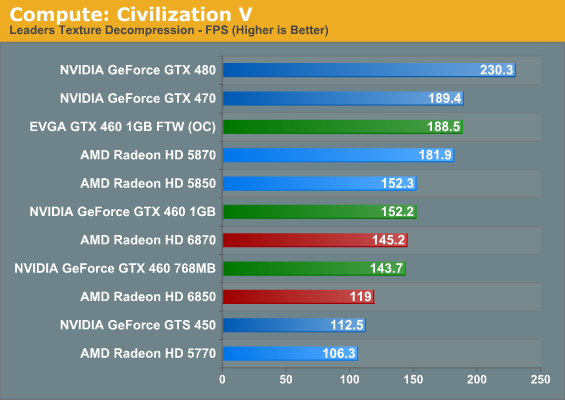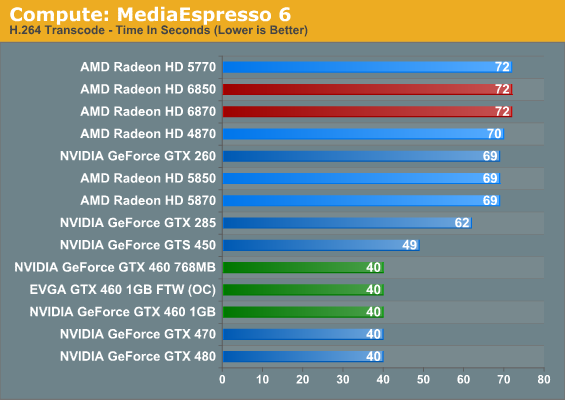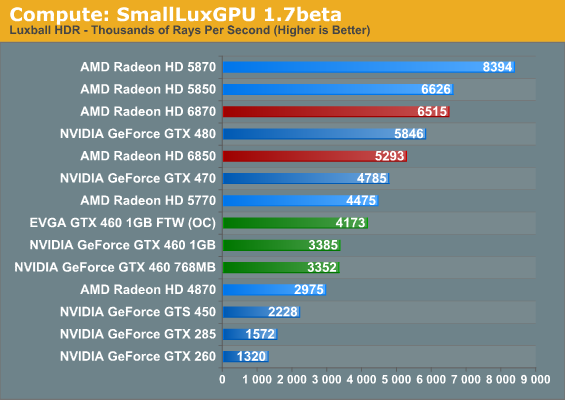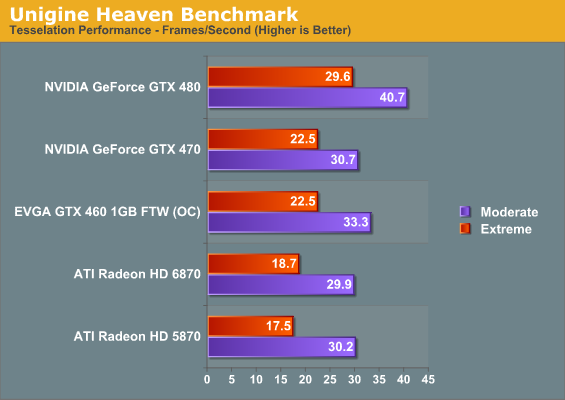AMD’s Radeon HD 6870 & 6850: Renewing Competition in the Mid-Range Market
by Ryan Smith on October 21, 2010 10:08 PM ESTFor a while now we’ve been trying to establish a proper cross-platform compute benchmark suite to add to our GPU articles. It’s not been entirely successful.
While GPUs have been compute capable in some form since 2006 with the launch of G80, and AMD significantly improved their compute capabilities in 2009 with Cypress, the software has been slow to catch on. From gatherings such as NVIDIA’s GTC we’ve seen first-hand how GPU computing is being used in the high-performance computing market, but the consumer side hasn’t materialized as quickly as the right situations for using GPU computing aren’t as straightforward and many developers are unwilling to attach themselves to a single platform in the process.
2009 saw the ratification of OpenCL 1.0 and the launch of DirectCompute, and while the launch of these cross-platform APIs removed some of the roadblocks, we heard as recently as last month from Adobe and others that there’s still work to be done before companies can confidently deploy GPU compute accelerated software. The immaturity of OpenCL drivers was cited as one cause, however there’s also the fact that a lot of computers simply don’t have a suitable compute-capable GPU – it’s Intel that’s the world’s biggest GPU vendor after all.
So here in the fall of 2010 our search for a wide variety of GPU compute applications hasn’t panned out quite like we expected it too. Widespread adoption of GPU computing in consumer applications is still around the corner, so for the time being we have to get creative.
With that in mind we’ve gone ahead and cooked up a new GPU compute benchmark suite based on the software available to us. On the consumer side we have the latest version of Cyberlink’s MediaEspresso video encoding suite and an interesting sub-benchmark from Civilization V. On the professional side we have SmallLuxGPU, an OpenCL based ray tracer. We don’t expect this to be the be all and end all of GPU computing benchmarks, but it gives us a place to start and allows us to cover both cross-platform APIs and NVIDIA & AMD’s platform-specific APIs.
Our first compute benchmark comes from Civilization V, which uses DirectCompute to decompress textures on the fly. Civ V includes a sub-benchmark that exclusively tests the speed of their texture decompression algorithm by repeatedly decompressing the textures required for one of the game’s leader scenes.

In our look at Civ V’s performance as a game, we noted that it favors NVIDIA’s GPUs at the moment, and this may be part of the reason why. NVIDIA’s GPUs clean up here, particularly when compared to the 6800 series and its reduced shader count. Furthermore within the GPU families the results are very straightforward, with the order following the relative compute power of each GPU. To be fair to AMD they made a conscious decision to not chase GPU computing performance with the 6800 series, but as a result it fares poorly here.
Our second compute benchmark is Cyberlink’s MediaEspresso 6, the latest version of their GPU-accelerated video encoding suite. MediaEspresso 6 doesn’t currently utilize a common API, and instead has codepaths for both AMD’s APP (née Stream) and NVIDIA’s CUDA APIs, which gives us a chance to test each API with a common program bridging them. As we’ll see this doesn’t necessarily mean that MediaEspresso behaves similarly on both AMD and NVIDIA GPUs, but for MediaEspresso users it is what it is.

We decided to go ahead and use MediaEspresso in this article not knowing what we’d find, and it turns out the results were both more and less than we were expecting at the same time. While our charts don’t show it, video transcoding isn’t all that GPU intensive with MediaEspresso; once we achieve a certain threshold of compute performance on a GPU – such as a GTX 460 in the case of an NVIDIA card – the rest of the process is CPU bottlenecked. As a result all of our Fermi NVIDIA cards at the GTX 460 or better take just as long to encode our sample video, and while the AMD cards show some stratification, it’s on the order of only a couple of seconds. From this it’s clear that with Cyberlink’s technology having a GPU is going to help, but it can’t completely offload what’s historically been a CPU-intensive activity.
As for an AMD/NVIDIA cross comparison, the results are straightforward but not particularly enlightening. It turns out that MediaEspresso 6 is significantly faster on NVIDIA GPUs than it is on AMD GPUs, but since we’ve already established that MediaEspresso 6 is CPU limited when using these powerful GPUs, it doesn’t say anything about the hardware. AMD and NVIDIA both provide common GPU video encoding frameworks for their products that Cyberlink taps in to, and it’s here where we believe the difference lies.
In particular we see MediaEspresso 6 achieve 50% CPU utilization (4 core) when being used with an NVIDIA GPU, while it only achieves 13% CPU utilization (1 core) with an AMD GPU. At this point it would appear that the CPU portions of NVIDIA’s GPU encoding framework are multithreaded while AMD’s framework is singlethreaded. And since the performance bottleneck for video encoding still lies with the CPU, this would be why the NVIDIA GPUs do so much better than the AMD GPUs in this benchmark.
Our final GPU compute benchmark is SmallLuxGPU, the GPU ray tracing branch of the open source LuxRender renderer. While it’s still in beta, SmallLuxGPU recently hit a milestone by implementing a complete ray tracing engine in OpenCL, allowing them to fully offload the process to the GPU. It’s this ray tracing engine we’re testing.

Compared to our other two GPU computing benchmarks, SmallLuxGPU follows the theoretical performance of our GPUs much more closely. As a result our Radeon GPUs with their difficult-to-utilize VLIW5 design end up topping the charts by a significant margin, while the fastest comparable NVIDIA GPU is still 10% slower than the 6850. Ultimately what we’re looking at is what amounts to the best-case scenarios for these GPUs, with this being as good an example as any that in the right circumstances AMD’s VLIW5 shader design can go toe-to-toe with NVIDIA’s compute-focused design and still win.
At the other end of the spectrum from GPU computing performance is GPU tessellation performance, used exclusively for graphical purposes. For the Radeon 6800 series, AMD enhanced their tessellation unit to offer better tessellation performance at lower tessellation factors. In order to analyze the performance of AMD’s enhanced tessellator, we’re using the Unigine Heaven benchmark and Microsoft’s DirectX 11 Detail Tessellation sample program to measure the tessellation performance of a few of our cards.

Since Heaven is a synthetic benchmark at the moment (the DX11 engine isn’t currently used in any games) we’re less concerned with performance relative to NVIDIA’s cards and more concerned with performance relative to the 5870. Compared to the 5870 the 6870 ends up being slightly slower when using moderate amounts of tessellation, while it pulls ahead when using extreme amounts of tessellation. Considering that the 6870 is around 7% slower in games than the 5870 this is actually quite an accomplishment for Barts, and one that we can easily trace back to AMD’s tessellator improvements.

Our second tessellation test is Microsoft’s DirectX 11 Detail Tessellation sample program, which is a much more straightforward test of tessellation performance. Here we’re simply looking at the framerate of the program at different tessellation levels, specifically level 7 (the default level) and level 11 (the maximum level). Here AMD’s tessellation improvements become even more apparent, with the 6870 handily beating the 5870. In fact our results are very close to AMD’s own internal results – at level 7 the 6870 is 43% faster than the 5870, while at level 11 that improvement drops to 29% as the increased level leads to an increasingly large tessellation factor. However this also highlights the fact that AMD’s tessellation performance still collapses at high factors compared to NVIDIA’s GPUs, making it all the more important for AMD to encourage developers to use more reasonable tessellation factors.










197 Comments
View All Comments
Donkey2008 - Friday, October 22, 2010 - link
Can you provide a link to your website so I can read your review of the cards? That would be awesome.Natfly - Friday, October 22, 2010 - link
Sure, right here: http://tinyurl.com/36ag36dBlendMe - Friday, October 22, 2010 - link
So you're telling me I can get two 6870 and spend lest money, use less power and have more performance than a GTX 480? I like the idea of going back to what made the 48xx cards so great. Small, cheap and expandable.Can't wait for the rest of the line up.
tpurves - Friday, October 22, 2010 - link
how is it that the nvidia cards go UP in framerate when you increase the resolution from 1650 to 1920 and add 4xAA? Did you mix up some test run numbers?mapesdhs - Friday, October 22, 2010 - link
It's a pity the charts don't include SLI results for the EVGA 460. I would like to have seen
how close it came to 470 SLI, given the 470s inferior power, GPU load temp and noise
results. The 470 GPU load temps under Crysis for just one card are particularly scary;
the idea of using two 470s SLI, and even more so oc'ing them, seems like a recipe for
thermal mayhem - alien astronomers with IR telescopes would wonder what the heck
they've spotted. :D
The price drop on the 470 is interesting, but the EVGA 460 still looks like a better buy
because of the power/heat issues, especially so for those considering SLI (as I am),
and also the fact that the EVGA is as good or better than the 6870. This graph is the
one that interests me:
http://images.anandtech.com/graphs/graph3987/33232...
The stock 460 SLI is clearly nowhere near as good as 6870 CF or 470 SLI, but given
a single EVGA 460 matches the 6870, I'd really like to know how two EVGAs perform.
Any chance you could add the data later?
On the other hand, one could assume the 6870 should have some oc'ing headroom,
but toms' review didn't show that much of a gain from oc'd 6870s.
The 6870 here in the UK seems to be about 200 UKP (Aria, Scan), though the XFX
version looks to be an exception (178 from Scan). The EVGA is 174 (Scan, but no
stock yet). For those who don't want to spend that much, the 800MHz Palit Sonic
Platinum 460 has dropped down to only 163 (last week it was 183). I almost bought
two of the Palit cards last week, so I'm glad I waited.
Obviously the pricing is all over the place atm, and likely to wobble all over again
when the next 6xxxx cards are released. Either way, despite the lack of major
performance increases atm, at least there's finally some pricing/value competition.
I think I'll wait until the dust settles re pricing, then decide. Quite likely many others
will do the same.
Ian.
AtenRa - Friday, October 22, 2010 - link
Why did you run at 1920x1200 and not 1920x1080 ??most 1920x1200 monitors are extincted from the market and 1920x1080 is becoming the defacto resolution.
Lunyone - Friday, October 22, 2010 - link
Well with bowing down to nVidia on the selection of "what" GPU to use, you have lost all credibility in my eyes. Even Tom's Hardware took a higher road and agreed to use the "hand picked" GPU, but limited the clocks to near stock settings, so there was a more "real" world comparison. Who nows if this isn't the first time that this has happened at Anandtech. I notice no rebuttals on Anand's part, so I'm guessing that they are quite amazed that people are seeing how one sided this issue is. This article wouldn't affect my purchase, since I look a several sites to draw a conclusion from. But my confidence in quality and fair reporting from Anandtech's reviews have been compromised, IMHO. I don't know if I will put any merit to any on Anand's reviews, time will tell.Sunburn74 - Friday, October 22, 2010 - link
Gee. You know whats all this about Anandtech losing credibility? Nvidia specifically asked them to test one card and the consumer benefits from having this information. Its not like anandtech didn't include the reference gtx460 as well. Anything that tells the consumer more about how valuable his dollar really is, is a good thing imo.I currently have an oced radeon 5850 and it annoyed the hell out of me trying to justify whether or not the extra 30 bucks I eventually ended up paying for it, was worth it. There weren't any reviews at the time you see...
SandmanWN - Friday, October 22, 2010 - link
You can't gauge value of an overclocked card against a stock card. You have no idea what the other card can do. What you are saying is nonsense if you really put two seconds into thinking about what you just said.mindbomb - Friday, October 22, 2010 - link
we are talking about factory oc'd cards.It's not like Anand was playing around in rivatuner.